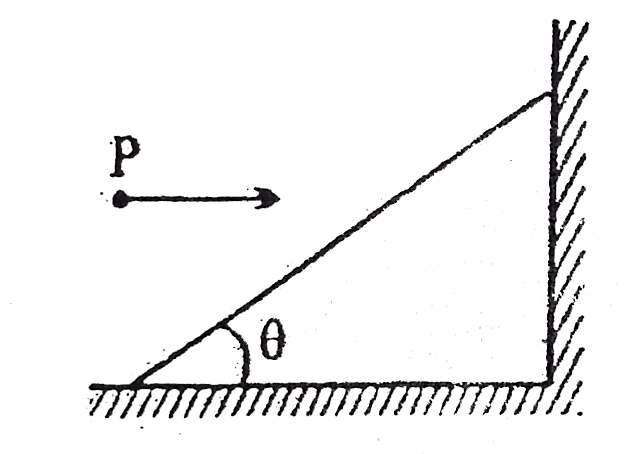A tennis ball bounces down a flight of stairs, striking each step in turn and rebounding to half to height of the step. The coefficient of restitution is
12
1√2
14
1
To find the coefficient of restitution for a tennis ball bouncing down a flight of stairs, we can follow these steps:
Step 1: Understand the Problem
The tennis ball bounces down the stairs, hitting each step and rebounding to half the height of the step it just fell from. We need to find the coefficient of restitution (e).
Step 2: Define Variables
Let:
- h = height of each step
- V = velocity of the ball just before it strikes the step
- V′ = velocity of the ball just after it rebounds from the step
Step 3: Calculate Velocity Before Impact
Using the equation of motion for free fall:
V2=U2+2gh
Where:
- U=0 (initial velocity before falling)
- g = acceleration due to gravity
Substituting the values:
V2=0+2gh⟹V2=2gh
Step 4: Calculate Height After Rebound
After rebounding, the ball reaches a height of h2. Using the same equation of motion:
(V′)2=0+2g(h2)⟹(V′)2=gh
Step 5: Relate Velocities Using Coefficient of Restitution
The coefficient of restitution is defined as:
e=relative velocity of separationrelative velocity of approach=V′V
From the previous steps, we have:
V′=eV
Step 6: Substitute and Solve for e
From the equations derived:
1. V2=2gh
2. (V′)2=gh
Substituting V′=eV into the second equation:
(eV)2=gh⟹e2V2=gh
Now, substituting V2=2gh into this equation:
e2(2gh)=gh
Dividing both sides by gh (assuming h≠0):
2e2=1⟹e2=12⟹e=1√2
Step 7: Conclusion
Thus, the coefficient of restitution e is:
e=1√2
Final Answer
The coefficient of restitution is 1√2.
---
The tennis ball bounces down the stairs, hitting each step and rebounding to half the height of the step it just fell from. We need to find the coefficient of restitution (e).
Let:
- h = height of each step
- V = velocity of the ball just before it strikes the step
- V′ = velocity of the ball just after it rebounds from the step
Using the equation of motion for free fall:
V2=U2+2gh
Where:
- U=0 (initial velocity before falling)
- g = acceleration due to gravity
V2=0+2gh⟹V2=2gh
After rebounding, the ball reaches a height of h2. Using the same equation of motion:
(V′)2=0+2g(h2)⟹(V′)2=gh
The coefficient of restitution is defined as:
e=relative velocity of separationrelative velocity of approach=V′V
V′=eV
From the equations derived:
1. V2=2gh
2. (V′)2=gh
(eV)2=gh⟹e2V2=gh
e2(2gh)=gh
2e2=1⟹e2=12⟹e=1√2
Thus, the coefficient of restitution e is:
e=1√2
The coefficient of restitution is 1√2.
Topper's Solved these Questions
- CENTRE OF MASS, IMPULSE AND MOMENTUMBOOK - DC PANDEY ENGLISHCHAPTER - CENTRE OF MASS, IMPULSE AND MOMENTUMEXERCISE - More a than one option is Correct
1 Videos
- CENTRE OF MASS, IMPULSE AND MOMENTUMBOOK - DC PANDEY ENGLISHCHAPTER - CENTRE OF MASS, IMPULSE AND MOMENTUMEXERCISE - Comprehension type questions
15 Videos
- CENTRE OF MASS, IMPULSE AND MOMENTUMBOOK - DC PANDEY ENGLISHCHAPTER - CENTRE OF MASS, IMPULSE AND MOMENTUMEXERCISE - Comprehension type questions
15 Videos
- CENTRE OF MASSBOOK - DC PANDEY ENGLISHCHAPTER - CENTRE OF MASSEXERCISE - Medical entrances gallery
27 Videos
- CENTRE OF MASS, LINEAR MOMENTUM AND COLLISIONBOOK - DC PANDEY ENGLISHCHAPTER - CENTRE OF MASS, LINEAR MOMENTUM AND COLLISIONEXERCISE - Level 2 Subjective
21 Videos
Similar Questions
A ball falls on the ground fro a height of 2.0 m and rebounds up to a height of 1.5 m. Find the coefficient of restitution.
View SolutionA 1.0 kg ball drops vertically into a floor from a height of 25 cm . It rebounds to a height of 4 cm. The coefficient of restitution for the collision is
View SolutionA ball is dropped from a height of 20 m in the floor and rebounds to 1.25 m after second collision, then coefficient of restitution e is
View SolutionA metal ball falls from a height of 1m on to a steel plate and jumps upto a height of 81 cm. The coefficient of restitution of the ball and steel plate is
View SolutionIn the figure shown, a particle P strikes the inclined smooth plane horizontally and rebounds vertically. If the angle θ is 60∘ then the coefficient of restitution is:

View SolutionA steel ball strikes a fixed smooth steel plate placed on a horizontal surface at an angle θ with the vertical. If the coefficient of restitution is e, the angle at which the rebound will take place is:
View SolutionA steel ball strikes a fixed smooth steel plate placed on a horizontal surface atan angle θ with the vertical. If the coefficient of restitution is e, the angle at which the rebound will take place is:
View SolutionTwo identical billiard balls are in contact on a table. A third identical ball strikes them symmetrically and comes to rest after impact. The coefficient of restitution is :
View SolutionA particle of mass m strikes a horizontal smooth floor with velocity u making an angle θ with the floor and rebound with velocity v making an angle θ with the floor. The coefficient of restitution between the particle and the floor is e. Then
View SolutionA ball is bouncing down a set of stairs. The coefficient of restitution is e. The height of each step is d and the ball bounces one step at each bounce. After each bounce the ball rebounds to a height h above the next lower step. Neglect width of each step in comparison to h and assume the impacts to be effectively head on. Which of the following relation is correct ?
View Solution
